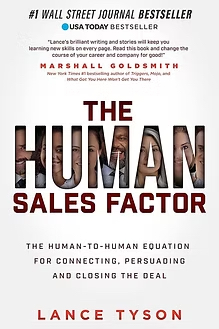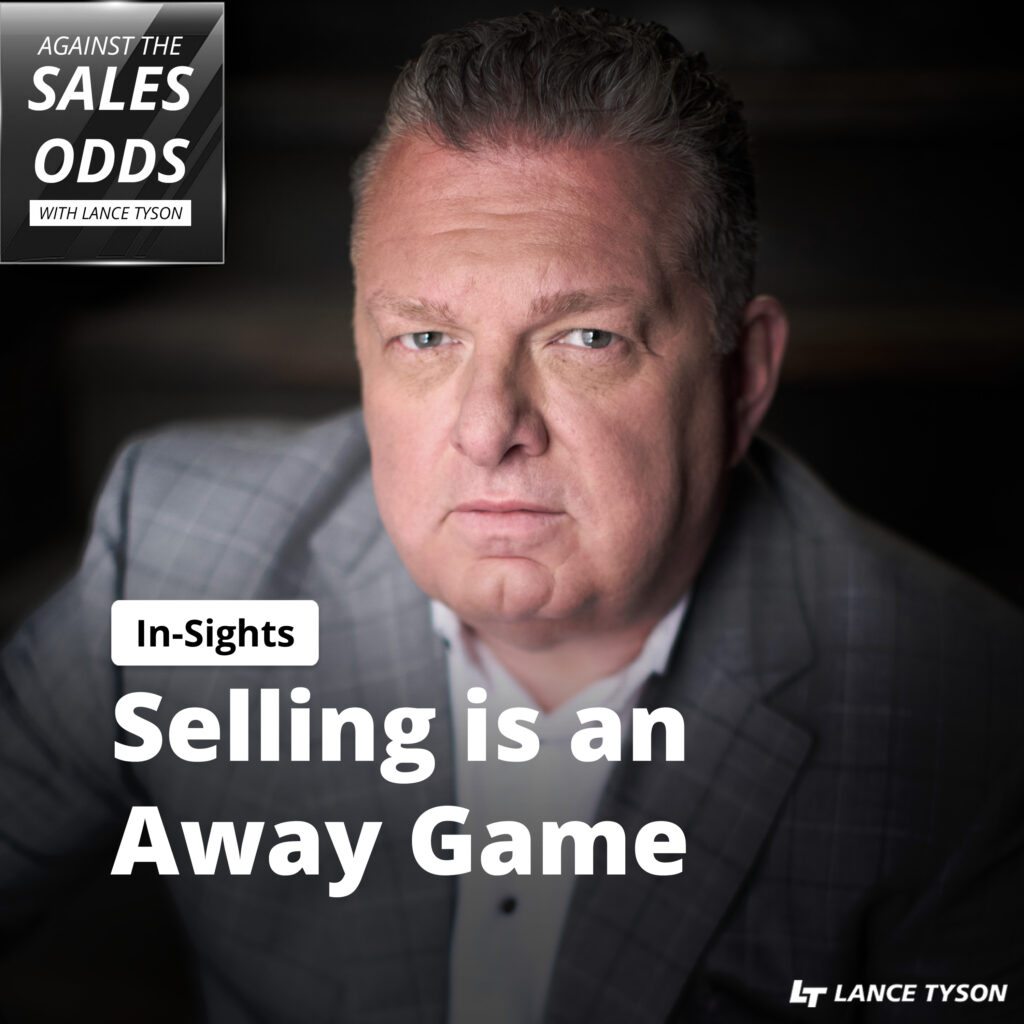In this short episode of In-Sights, Lance Tyson discusses the read offense strategy from his bestselling book, ‘Selling is an Away Game’. He breaks down how sales professionals can assess and adapt to their buyer’s needs in real time, much like a quarterback reading the defense. Learn actionable insights on how to stay one step ahead, anticipate objections, and tailor your approach to close more deals. Whether you’re a seasoned sales expert or just starting out, this episode will help you fine-tune your game plan for success.
Lance is the bestselling author of Selling Is An Away Game and The Human Sales Factor.
You can purchase these books at: https://www.tysongroup.com/books
Be sure to sign up for Lance’s LinkedIn newsletter here: https://www.linkedin.com/build-relation/newsletter-follow?entityUrn=7123326552678805504
Love the show? Subscribe, rate, review, and share! https://www.tysongroup.com/podcast
—
Listen to the podcast here
In-Sights: How A Salesperson Teach, Tailor And Drive Insight
We know things are changing in the marketplace and they’re changing in different industries. One of the metaphors that we talk about is this read offense mindset for salespeople and sales leaders as they’re approaching things situationally and what different strategies or tactics could they use to win. I’m going to read from, from my book, The Human Sales Factor, about a study that was done by Florida State a few years ago. It was one of our competitors, The Challenger Sale.
The Challenger Sale was originally a research book written by the CEB or Corporate Executive Board. They have since sold to a research company called a consulting company called Gartner. The Challenger Sale was a book about how a salesperson really had to teach, tailor, and drive insight. I agree with those three things. It’s well said. Good salespeople and good business people always do those three things.

A professor of Florida State named Leff Bonney did a study to challenge the thought process on The Challenger Sale. This was a couple of years ago. They looked at high-performing salespeople. What they were trying to do was create a little bit of an argument about the findings of The Challenger Sale. Florida State Sales Institute looked at hundreds of sales executives all wanting to know the same thing. Which sales methodology is best for the company? This challenger sales model is coming out and everybody’s jumping aboard.
They went to survey about 783 salespeople in 8 different industries. They wanted them to self-identify their style. As they started to look at some things, one person said, “I can’t fill out your survey as I’m the kind of seller that depends on the situation I’m in.” That statement got the attention of the researchers. A single sales strategy could not work in every situation is what they determined.
Dominant High Performers
They went and redid their study. They looked at 1, 500 salespeople from 3 different industries. Here’s what they found. It’s really interesting. What they found in this study was that high performers had a dominant style based on the situation. Right off that statement, this one salesperson said, “I can’t say it’s one methodology. It depends on the situation I’m in.” As they redid the study on even more salespeople, they found that there were clear patterns and win-loss rates when you account for both the situation that the salesperson was in and the strategy.
I talked before in one of these episodes about how pressure on sales leaders and salespeople draws out the right plan. What this read offense study was saying is that high performers were more likely to deploy the strategy with the best odds compared to the rest of the organization. What that means is they had multiple strategies and tactics that at least they were planning for them going into a sale.
High sales performers were more likely to deploy the strategy with the best odds compared to the rest of the organizations.
The study said, “The only accurate label that you can put on high performers is that they’re agile situational sellers.” What does that mean? Let’s create a little bit of an analogy for you. Think about this for a sec. Number one, read offense. Imagine a quarterback, whoever your quarterback is. Think of Tom Brady or any quarterback you like in college or pro.
They get a call in from the sideline saying, “This is the play. We’re going to run a run play, whether we’re going to come up on the 2-hole or the 4-hole.” The quarterback gets to the line of scrimmage and the defense is giving a much different look. They decide, “I’m going to call an audible here.” That’s much like what we’re being asked to do in different scenarios in sales.
Think of a fighter pilot. Maybe you saw Top Gun. Maybe you saw the original one. Maybe you saw the one that came out in 2022. What a fighter pilot was doing in the dogfight is situational. Colonel Robert Boyd created modern dogfighting. He created a system called an OODA Loop. O stands for Observe. The other O stands for Orient. D stands for Decision. A stands for Act. You’re trying to make moves to get the other pilot to move. It’s all situational.
Think of a SEALs team. I got interviewed one time for a podcast by a SEAL team member. It was SEAL Team 4. This is early on in the Persian Gulf War. I said, “What was the success rate of your SEAL team?” He goes, “Our success rate was over 75%.” I said, “How often was what you prepped for the actual situation or the mission?” He said, “Less than 30%.” I said, “How many scenarios did you prep for?” He goes, “About 6 to 8.”
That’s what’s happening to us at sales. We’re having to go in and have multiple strategies. For instance, you could be going into a sales call where you have 3 or 4 buyers. Normally, you’re used to meeting people face to face, but now, part of the sales process is on Zoom or Teams. You could walk into a Zoom or Teams call and have half the group or none of the group on camera and you’re the only one there. It’s like you’re talking to yourself.

Read Offense Strategy: When you enter online meetings on Zoom or Teams, you can only see half the group on the camera. Sometimes, you only see yourself, and it is like you are talking to yourself.
Fragmented Sales Process
We’ll talk in some other episodes about what we’re doing a lot of studies on in the Tyson Group. We do a lot of research. We take a lot of data and we assess. We have a diagnostic that we use called Sales Team Science. We do a lot of interviews prior to customizing our training, coaching, or consulting. What we know is as you look at these different strategies and different scenarios, you could be asked to do different things, but what we also know from this research is the sales process is extremely fragmented at this point.
It’s so fragmented that, in fact, it’s increasing sales cycle time. As far as we can see based on our customer base, it is anywhere from 15% to 30% longer. That can be in additional meetings. That could be in a timeframe of additional quarters, months, or whatever that looks like. Also in this read offense, maybe you’re a surgeon and you do shoulders, knees, or labrum. Think how that doc has to act if they have an 18 to 21-year-old athlete on the table as opposed to a 50-year-old that might be slightly porky and with high blood pressure. You have to be ready very situationally.
What we’re calling for in this read offense is salespeople are forced as they’re blueprinting things to do a lot of pre-approach and to be thinking of the minds of the buyer. If you want to sell to John Brown, would John Brown buy? You have to see things through John Brown’s eyes. A lot of our clients deal with buyers that could be anywhere from 3 buyers to 6 buyers in any given situation, which then would require potentially multiple strategies and certain tactics that will win the day or the meeting. In summary, we have to be prepared to shift the strategy based on the situation. It’s going to require us as sales leaders and salespeople to be adaptable, agile, and pliable. I hope this helped.
Important Links
The Human Sales Factor The Challenger Sale In-Sights: The Current Sales Landscape




